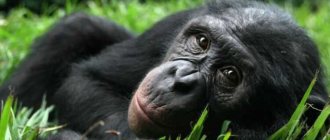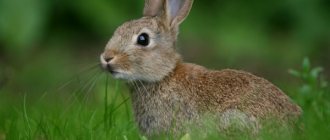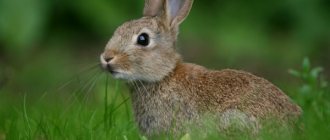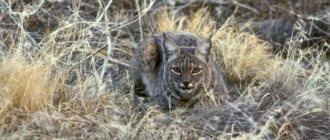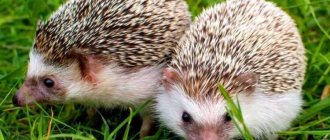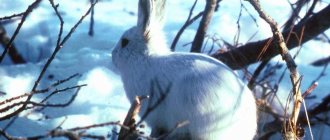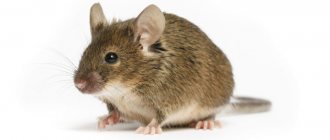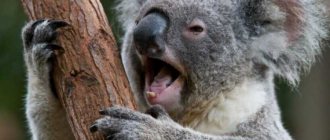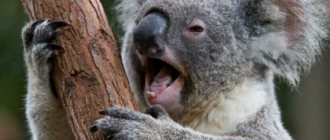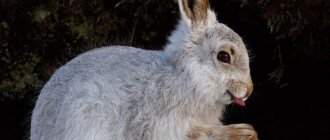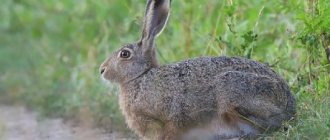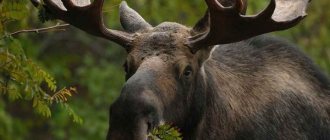Hares (genus Lepus), lagomorphs, are mammals that number about 30 species and belong to the same family as rabbits (Leporidae). The difference is that hares have longer ears and hind legs. The tail is relatively short, but slightly longer than that of rabbits. People often incorrectly apply the names hare and rabbit to specific species. Pikas, rabbits and hares make up the order of lagomorphs.
Hares are the largest lagomorphs. Depending on the species, the body is about 40–70 cm long, the legs up to 15 cm and the ears up to 20 cm, which appear to dissipate excess body heat. Typically gray-brown in temperate latitudes, hares living in the North molt and “put on” white fur in winter. In the Far North, hares remain white all year round.
Reproduction cycles of hares
One of the most dramatic ecological patterns known to zoologists is the breeding cycle of hares. Populations peak every 8–11 years and then plummet by a factor of 100. Predators are believed to be responsible for this pattern. Hunter populations correlate with prey populations, but with a time lag of one to two years. As the number of predators increases, the number of hares decreases, but due to the high level of hunting, the number of predators also decreases.
Once the hare population recovers, the number of predators increases again and the cycle repeats. Because hares are almost exclusively herbivores, they damage natural vegetation or crops when their populations are high. Like rabbits, hares provide people with food and fur and are part of hunting and, more recently, popular culture.
Agouti (humpback hare): description
The unusual hare belongs to the order of rodents. As mentioned earlier, he looks a lot like a large guinea pig. He got his paws from the hare - they are relatively long. The agouti's back is rounded: it gives the impression that the animal is humpbacked, which is why it got its name - the humpbacked hare. The head is elongated, the ears are small - they resemble a short-eared hare. The tail is almost invisible, its size is so small. There are only three toes on the hind limbs. Experts in the animal world noticed similarities in the rodent with the distant ancestors of the modern horse. In a word, agouti cannot be confused with any other rodent.
The body length of the animal is about 60 cm, weight can reach up to 4 kg. The hare's fur is thick and coarse with a beautiful shiny sheen. On the belly of all species it is equally light, and on the back it can vary from black to bright golden with an orange tint.
The most interesting species of hares in the world
Brown hares (Lepus europaeus)
Adult hares are approximately the size of a domestic cat; there is no uniform standard for size and fur color. They have distinctive long ears and large hind feet that form the typical footprint of a hare in the snow. The hares that live in England are smaller than the European continental individuals. Females are larger and heavier than males. The topcoat is usually brown, tan, or greyish-brown, the belly and underside of the tail are pure white, and the tips of the ears and the top of the tail are black. The color varies from brown in summer to gray in winter. Long whiskers are visible on the nasal lips, muzzle, cheeks and above the eyes.
Brown hare – video
Antelope hares (Lepus alleni)
Size is a distinguishing feature; this is a large variety of hares. The ears are tall, averaging 162 mm in length, and are hairless except for white fur around the edges and tips. The lateral parts of the body (limbs, hips, croup) are gray with black tips on the hairs. On the ventral surface (chin, throat, belly, insides of the limbs and tail) the fur is gray. The upperparts are yellow/brown with small patches of black.
Antelope hares have many ways to cope with the heat. Fur is highly reflective and insulates the skin, eliminating heat buildup from the environment. When it gets cold, antelope hares reduce blood flow to their large ears, which reduces heat transfer.
Tolai hare (Lepus tolai)
There is no single color standard for these hares, and the shade depends on the habitat. The upperparts become dull yellow, pale brown or sandy gray with brownish or reddish stripes. The thigh area is buffy or gray. The head has pale gray or yellowish fur around the eyes, and this shade extends forward to the nose and back to the base of the long, black-tipped ears. The lower part of the body and sides are pure white. The tail has a wide black or brownish-black stripe on top.
Yellowish hare (Lepus flavigularis)
The fur of these hares is coarse, and their paws are well furred. The upperparts are a rich ocher color interspersed with black, and the back of the neck is adorned with a distinct stripe, adjacent to which are two narrow black stripes running back from the base of each ear. The ears are buff colored with whitish tips, the throat is yellowish, and the underparts and sides are white. The legs and hindquarters are pale whitish to gray, the tail is gray below and black above. In spring, the fur appears dull, the upper body becomes more yellowish, and the black stripes on the neck are visible only as black spots behind the ears.
Broom hare (Lepus castroviejoi)
The Spanish hare's fur is a mixture of brown and black with very little white on the upper body. The lower part of the body is all white. The top of the tail is black and the underside of the tail matches the body in white. The ears are brownish-gray and usually tipped with black.
Description and features of the sea hare
The seal bearded seal is nicknamed by Russian St. John's worts. They had difficulty obtaining seals of the only species of the genus Erignathus. Lahtaki are shy and cautious, like hares. Associations with long-eared seals were added by the way seals move on land. Outside the water, sealed seals hop like hares.
The bearded seal's size is not that of a hare. The seal is heavy, recognized as the largest in the marine fauna of Russia. Individual individuals weigh 360 kilograms. Average weight 220-280 kilos. Females rarely exceed 217 kilograms. Almost half of the mass is fat.
The bearded seals reach 2.5 meters in length. At the same time, the girth of the pinniped’s chest reaches 161 centimeters. Against this background, the seal's head looks miniature. If the sealed seal had long ears, as befits a hare, the impression would be different.
However, the seal only has internal shells. They look like holes on the sides of the head.
The pinniped hare has almost no neck. This is typical for many seals. But the location of the front flippers almost at the neck is atypical. In addition, the animal’s limbs are shifted to the center of the body, and not to the sides.
The bearded seal is painted in gray and white tones. A darker but blurred stripe runs along the back. There are sometimes light spots on the head.
The sea hare moves by jumping like hares that live on land
The sea hare, a mollusk, also vaguely resembles a true hare. The animal, which looks like a large slug, has parapodia. These are lateral tissue growths. They make the body of allisia massive. But the leg on which the mollusk crawls is narrowed and elongated.
Parapodia are useful for the sea hare in swimming. By straightening its lateral outgrowths, the mollusk floats in the water. At the same time, the parapodia contract, like the pectoral fins of stingrays.
In the photo, the sea hare “gives away” the secret of its name. There are horns on the animal's head. They stand up and sway like a hare's ears.
Another distinctive feature of the species is the gill slits on the right side of the body. The holes are hidden under a fold of the animal's mantle.
Allisia weighs 300-600 grams, depending on the type. Among tropical shellfish, it is not the most bulky, but large.
The color of the mollusk varies. There are brown, purple, yellow, black, gray and even spotted species. The color is added by the liquid that the hares have learned to release towards their enemies, like cuttlefish.
The sea hare mollusk protects itself by secreting a liquid that suppresses the appetite of predators
Only in mollusks the secret is not black, but colored. Most often, the protective liquid is red. It literally kills the attackers' appetite, containing special substances that suppress the feeling of hunger.
Other types of hares
Subgenus Poecilolagus
American hare
Subgenus Lepus
Arctic hare
White hare
Subgenus Proeulagus
Black-tailed hare
White-sided hare
Cape hare
Bush hare
Subgenus Eulagos
Corsican hare
Iberian hare
Manchurian hare
curly hare
White-tailed hare
Subgenus Indolagus
Dark-necked hare
Burmese hare
Uncertain subgenus
Japanese hare
Where do representatives of the lagomorph species most often live?
Hares and rabbits are found almost throughout the world in a variety of environments, from dense forests to open deserts. But the habitat of hares is different from the habitat of rabbits.
Hares mainly live in open areas, where speed is a good adaptation for escaping predators. Therefore, they live in the arctic tundra, grasslands or deserts. In these open areas, they hide in bushes and among rocks, their fur camouflaging them with their surroundings. But hares in snowy regions and partly mountain and Manchurian hares prefer coniferous or mixed forests.
You will find rabbits in forests and areas with bushes, where they hide in vegetation or in burrows. Some rabbits live in dense tropical forests, while others hide among river bushes.
In what bodies of water is it found?
The bearded seal is an inhabitant of northern latitudes. Animals occupy the shallow waters of the Arctic Ocean. Seals of this species do not swim further than Hudson Bay. Towards the Pacific Ocean, hares are distributed as far as the Tartary Strait.
Loving the north, bearded seals do not “wander” to the Pole. Single individuals ended up at the ends of the earth on drifting ice floes, separated from the animals’ native coasts. By the way, they are predators. The bearded seals' favorite delicacy is gastropods.
The seal's namesake could just fall into its mouth. However, the sea hare clam lives in tropical seas. The habitats of the species do not overlap.
Since the hare clam lives in warm waters, lobsters and starfish feast on it. The herbivorous creature protects itself with ink and camouflages itself with the color of the bottom. This is partly due to the variety of allisia coloring patterns.
Allisia is widely distributed. Sometimes the animal “wanders” into the subtropics. But the main concentration of sea hares is observed near the equator.
How lagomorphs escape from predators
Hares run away from predators and confuse hunters when they return. Rabbits take refuge in burrows. Therefore, hares travel considerable distances and have a wide range, while rabbits remain in close proximity to safe shelters in small areas. All lagomorphs use distress calls or strike the ground with their hind feet to warn of a predator.
A hare escapes from a lynx
Hares have keen hearing, but scent marking is another way of communication. They have scent glands on the nose, chin and around the anus.
Species of sea hare
In the north, the sea hare lives alone. Giant seals are not divided into subspecies. But the classification of the tropical hare is extensive. The dwarf species does not exceed 7 centimeters in length. The color of the animal is olive, burgundy or brown. Dark individuals have been spotted in the Indian Ocean and Red Sea.
The largest allisia is the Californian one. Representatives of the subspecies reach a length of 75 centimeters. True to their name, giants live on the Pacific coasts along North America.
California Allysia is the largest species of sea hare
Often reaching only half a meter in length, California allisias weigh approximately 7 kilograms. Not every predator can swallow such a mollusk. Californian individuals are attacked mainly by giant green anemones and large lobsters.
The black sea hare competes in size with the California clam. The subspecies owes its color to the food it consumes. Clams eat dark algae. However, we’ll talk about the nutrition of sea hares separately.
In the photo there is a black sea hare
What do lagomorphs eat?
All hares and rabbits are strictly herbivores. The diet includes green parts of plants, grasses, clover, cruciferous and complex plants. In winter, the diet includes dry twigs, buds, young tree bark, roots and seeds. In steppe regions, the winter diet consists of dry weeds and seeds. Most of all, hares like cultivated plants such as winter grains, rapeseed, cabbage, parsley and cloves. Hares and rabbits damage cereals, cabbage crops, fruit trees and plantations, especially in winter. Hares rarely drink; they take moisture from plants, but sometimes they eat snow in winter.
Features of behavior
Agoutis are diurnal. The animals live either in pairs or in small families. If rodents create a pair, they will exist for the rest of their lives. Agouti usually chooses areas near water bodies as my habitat in nature. Rodents rarely leave their favorite place; the area for searching for food can only change. Agouti will defend their territory not only from strangers, but also from relatives.
At night, the animals hide in burrows or tree hollows. In nature, agoutis are shy and avoid meeting people, but when kept in captivity they quickly get used to their owner and willingly make contact. If the olive agouti senses danger, it freezes, and when it is convinced that the predator is definitely hunting it, it quickly runs away. The rodent does not run in a straight line, but in ornate zigzags, trying to find reliable shelter.
It is very interesting to watch how rodents feed: the animal sits on its hind legs and holds food with its front limbs. Agoutis are practically the only animals that can crack the tough shells of Brazil nuts. Their strength and incredibly sharp teeth help them in this. Agouti's favorite food is seeds and fruits of plants, roots, and young vegetation. Agoutis will not refuse to eat sugar cane and bananas and often cause significant damage to the plantations of these plants.
Catching an agouti is an incredibly difficult task. The animals run quickly and develop amazing speed. Moreover, rodents have excellent hearing, a keen sense of smell, and these abilities help agouti avoid encounters with predators. One minus is that the animals see poorly. But agoutis are excellent swimmers and in water they maintain the same speed of movement as when running.
You can see an agouti any day at the Lazarevsky Oceanarium “Tropical Amazon”, but in the meantime we invite you to watch a fascinating video about these animals:
See information about other inhabitants of the aquarium:
- River tropical fish and animals
- Marine tropical fish and animals
- Tropical inhabitants of the exotarium
- Gentoo penguins - inhabitants of the penguinarium
Features of reproduction
Lagomorphs live without pairs. During the mating season, males fight with each other, building a social hierarchy in order to gain access to females entering the estrous cycle. Hares reproduce quickly, producing several large litters each year. Bunnies are born completely covered in fur, with their eyes open, and jump within minutes of being born.
After birth, mothers feed their babies only once a day with nutritious milk. The litter size of hares and rabbits depends on geography and climate.
Sea hare feeding
Hares seals dive for prey to a depth of about 70 meters. Sometimes, animals descend 150 meters. Here bearded seals find not only mollusks, but also crustaceans. Hares do not compete with the walruses living nearby. A related species also feeds on mollusks, but prefers valved ones with shells.
Mollusc hares live and feed at depths of about 20 meters. Here allisia looks for plant food and places to attach its legs. The latter mollusk prefers to cling to stones and rocky ledges.
Accordingly, you should look for sea hare in areas of the seabed with complex terrain, boulders and an abundance of algae.
